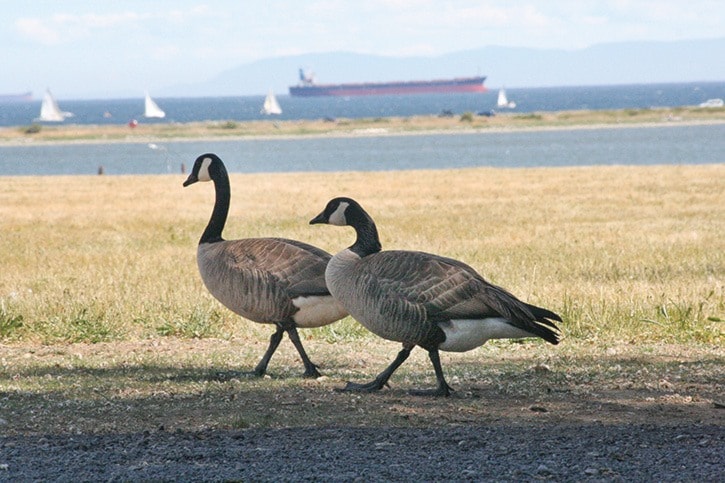What’s good for the goose isn’t necessarily good for the grounds crew at Royal Roads University.
Head gardener Barrie Agar and her staff regularly have to deal with the droppings from the geese that frequent the university grounds, and it’s a problem that Agar, with 17 years of experience, said is getting worse.
“I think before they might have moved around in different areas, but I think it might be tougher now … I think people are probably being a bit more proactive about moving them out, or they just like it here, I don’t know … I can’t presume to read their tiny little bird brains,” she said, laughing.
 Agar said the university’s fowl population tends to increase in the summer, but she spotted a large flock of geese on the grounds near Esquimalt Lagoon this week. The population, said to be introduced to the region for hunting purposes decades ago, aren’t of the migratory kind, so they tend to stick around.
Agar said the university’s fowl population tends to increase in the summer, but she spotted a large flock of geese on the grounds near Esquimalt Lagoon this week. The population, said to be introduced to the region for hunting purposes decades ago, aren’t of the migratory kind, so they tend to stick around.
“They seem to have lost that migratory instinct,” Agar noted.
A 2012 report from the Capital Regional District showed that geese populations were highest on the Peninsula, but that the West Shore, particularly Colwood and Metchosin, maintained high populations as well.
Counts for Colwood were higher in the summer months of June to August than at any other time of year, but even the winter saw populations of over 100 birds.
The same report listed an area south of the university, within what’s now the Royal Bay development, as a breeding habitat.
The CRD had permission to cull 250 geese in 2015, but only managed to locate and kill 43 birds, as predicting the location of the birds proved to be difficult.
In the past the regional district has also performed egg addling operations, which involves preventing fertilized eggs from hatching then placing the eggs back into the nest.
Agar believes the most humane and sensible way of dealing with the geese is to use dogs to disrupt the routines of the geese, an idea that she has proposed to Royal Roads officials.
Even that solution could be problematic, however, as geese tend to work around canine obstacles pretty quickly, figuring out times when the dogs will be on the site and when they’ll be patrolling the area.
“It’s a long training process and it can take two years. They will keep trying,” Agar said of the dogs. “(The geese) have very good recognition.”
In the meantime, she and the rest of the crew at the university will simply have to keep their shovels handy.
“It’s a mess,” she said. “We have a lot of people moving through, so we have to keep cleaning up the pathways.”
joel.tansey@goldstreamgazette.com
